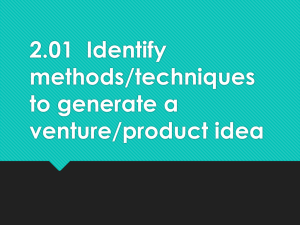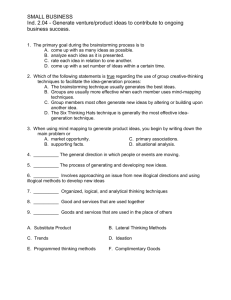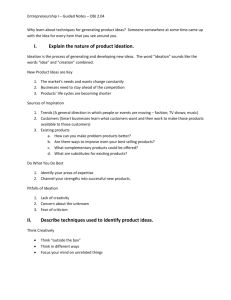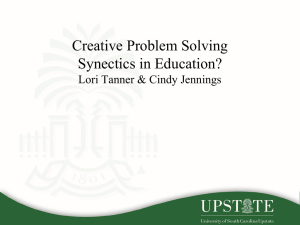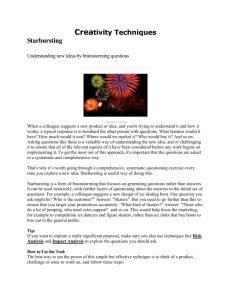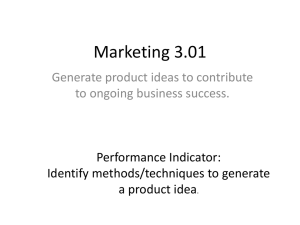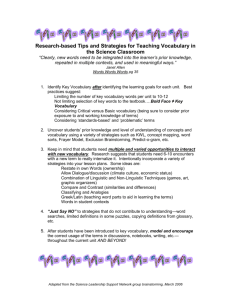2.01 PPT - Duplin County Schools
advertisement
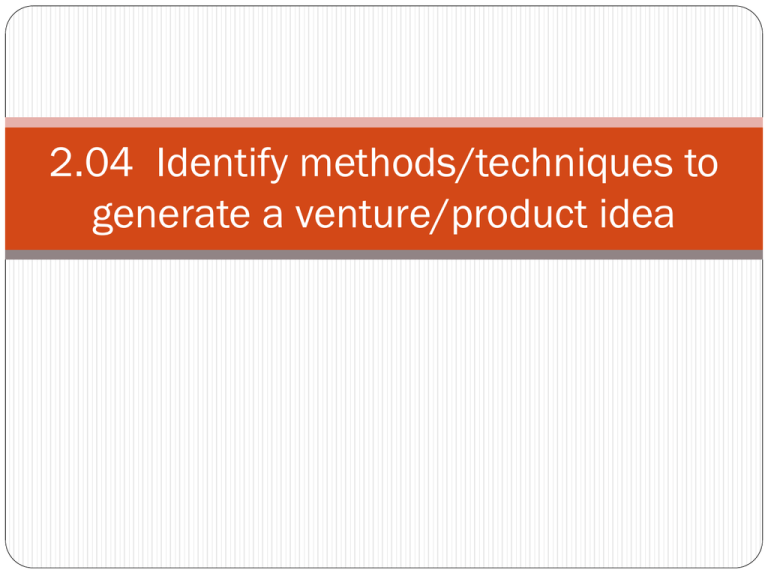
2.04 Identify methods/techniques to generate a venture/product idea Key Terms Attribute Listing-focuses on an attribute or an object in order to determine how the attribute can be improved. Ex. Cell phone features. Lateral Thinking-Solving problems through an indirect or creative approach. Ex. Thinking outside of the box. Analogies- Similarity of like features of two things. Ex. Comparing Associations-A mental connection or relation between thoughts, feelings, ideas or sensations. Brainstorming-is a creative-thinking technique involving the identification of as many different ideas as possible during a certain time frame. Key Terms Synectics-bringing different things together to create a unified connection. Sketching and doodling-Letting your subconscious do the drawing. Forced questioning-Force people to choose between two choices when neither of the choices could be the answer or needs further explanation. Ex. Is this yellow or green? Morphological Analysis-Systematically structuring and investigating many possible relationships of complex problems. Ex. Used to create a new product. The role of criticism in idea creation Criticism can be difficult to hear. Don’t take it personal Some of your most important lessons can come from complaints and criticism. Discussion points: As a business owner, how would you address these criticisms? The package is too hard to open The cake doesn’t taste fresh Your services are too expensive His store is very difficult to find Types of brainstorming techniques Define the problem Share ideas without criticism Build on others ideas Pose an initial question Use word association Identify a challenge Why learn about techniques for idea generation? Someone somewhere at sometime came up with the idea for every item that you see around So that you can invent the next great product Product ideas come from different places—existing products made better or brand new products Ideation is the process of generating and developing new ideas One of the primary purposes in business is to generate ideas for new goods and services Businesses need product ideas because. . . Markets change constantly They need to stay ahead of the competition Product life cycles are becoming shorter Where do businesses look for inspiration for need products? Trends—the general direction in which people or events are moving (fashion, TV, music, etc) by studying trends, business get a sense of what customers need—examples: health and fitness, baby boomers needs, communication needs. Customers—observe and notice when problems exist of people seem to have an unfulfilled need—talk with them (surveys, focus groups, satisfaction cards, one-on-one conversations)—talk to the people who deal with the customers (salespeople) Existing products—find the limitation and make them better— look to develop complimentary products (they “go with” another product)—look to develop substitute products (takes the place of another product)—examples: blu-ray to replace DD and digital books to replace hard/paperback books Methods of creative thinking used to generate new product ideas 1. Lateral thinking methods—involve approaching an issue from new illogical directions and using illogical methods to develop new ideas Brainstorming includes relay, round robin, brain drawing, free association, forced questioning, synectics, forced analogies, starbursting, mind mapping Relay—teams responding to teammates ideas in a certain order Round robin—no teams—participants respond in order Brain drawing—members add to drawings to try to develop a product Free association—state the first thing that comes to mind Methods, continued Forced questioning—used to answer a specific question Synectics—making connections through forced relations (two items that seem unrelated to find a new practical combination)— more time consuming than brainstorming but it is good when other creative methods have failed) Forced analogies—using metaphors and similes to create connections where non exist (i.e., waiting on the bus on a cold day-- think of other times you wait, like a doctors’ office to help you come up with a solution) Starbursting—draw a 6 pointed star and write the product opportunity in the middle—write the following words at the tip of the star (who, what, why, when, where and how)—answer each question based on the recognized product opportunity Methods, continued Mind mapping—in the center of the paper write the main problem, which the market opportunity that you identified— from the starting point, draw a line to other words and phrases that are related to the main idea—from each of the these words, draw other lines that relate to the particular word and so on—this helps to expand thinking and get lots of different ideas down on paper Methods, continued 2. Programmed thinking methods—organized, logical, and analytical thinking techniques Attribute listing—list the products characteristics that make it unique from other goods then find ways to improve those attributes Morphological analysis—list a products characteristics then combine some or all of those to create a new product Making it pay New product ideas are essential for long term business success No two businesses use the same exact method to develop products

